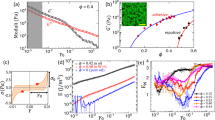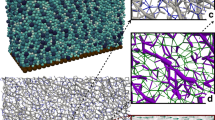Abstract
For years, engineers have used elastic and plastic models to describe the properties of granular solids, such as sand piles and grains in silos1,2,3. However, there are theoretical4,5,6 and experimental7,8,9,10,11,12,13,14 results that challenge this approach. Specifically, it has been claimed4,5,6 that stress in granular solids propagates in a manner described by wave-like (hyperbolic) equations, rather than the elliptic equations of static elasticity. Here we report numerical simulations of the response of a two-dimensional granular slab to an external load, revealing that both approaches are valid—albeit on different length scales. For small systems that can be considered mesoscopic on the scale of the grains, a hyperbolic-like, strongly anisotropic response is expected. However, in large systems (those typically considered by engineers), the response is closer to that predicted by traditional isotropic elasticity models. Static friction, often ignored in simple models, plays a key role: it increases the elastic range and renders the response more isotropic, even beyond this range.
This is a preview of subscription content, access via your institution
Access options
Subscribe to this journal
Receive 51 print issues and online access
$199.00 per year
only $3.90 per issue
Buy this article
- Purchase on Springer Link
- Instant access to full article PDF
Prices may be subject to local taxes which are calculated during checkout




Similar content being viewed by others
References
Nedderman, R. M. Statics and Kinematics of Granular Materials (Cambridge Univ. Press, Cambridge, 1992)
Savage, S. B. in Physics of Dry Granular Media (eds Herrmann, H. J., Hovi, J. P. & Luding, S.) 25–95 (NATO ASI Series, Kluwer, Dordrecht, 1998)
Jackson, R. in Theory of Dispersed Multiphase Flow (ed. Meyer, R. E.) 291–337 (Academic, New York, 1983)
Wittmer, J. P., Claudin, P., Cates, M. E. & Bouchaud, J.-P. An explanation for the central stress minimum in sand piles. Nature 382, 336–338 (1996)
Bouchaud, J.-P., Claudin, P., Levine, D. & Otto, M. Force chain splitting in granular materials: a mechanism for large-scale pseudo-elastic behaviour. Eur. Phys. J. E 4, 451–457 (2001)
Tkachenko, A. V. & Witten, T. A. Stress propagation through frictionless granular material. Phys. Rev. E 60, 687–696 (1999)
Drescher, A. & de Josselin de Jong, G. Photoelastic verification of a mechanical model for the flow of a granular material. J. Mech. Phys. Solids 20, 337–351 (1972)
Geng, J. et al. Footprints in sand: the response of a granular material to local perturbations. Phys. Rev. Lett. 87, 035506 (2001)
Geng, J., Reydellet, G., Clément, E. & Behringer, R. P. Green's function measurements of force transmission in 2D granular materials. Physica D 182, 274–303 (2003)
Mueggenburg, N. W., Jaeger, H. M. & Nagel, S. R. Stress transmission through three-dimensional ordered granular arrays. Phys. Rev. E 66, 031304 (2002)
Moukarzel, C. F., Pacheco-Martinez, H., Ruiz-Suarez, J. C. & Vidales, A. M. Static response in disk packings. Granular Matter 6, 61–66 (2004)
da Silva, M. & Rajchenbach, J. Stress transmission through a model system of cohesionless elastic grains. Nature 406, 708–710 (2000)
Smid, J. & Novosad, J. Pressure distribution under heaped bulk solids. In Proc. 1981 Powtech Conf., Institution of Chemical Engineers Symp. 63, D3/V/1–12 (1981).
Brockbank, R., Huntley, J. M. & Ball, R. C. Contact force distribution beneath a three-dimensional granular pile. J. Phys. II 7, 1521–1532 (1997)
Vanel, L., Howell, D., Clark, D., Behringer, R. P. & Clément, E. Memories in sand: experimental tests of construction history on stress distributions under sandpiles. Phys. Rev. E 60, R5040–R5043 (1999)
Serero, D., Reydellet, G., Claudin, P., Clément, E. & Levine, D. Stress response function of a granular layer: quantitative comparison between experiments and isotropic elasticity. Eur. Phys. J. E 6, 169–179 (2001)
Goldenberg, C. & Goldhirsch, I. Force chains, microelasticity, and macroelasticity. Phys. Rev. Lett. 89, 084302 (2002)
Reydellet, G. & Clément, E. Green's function probe of a static granular piling. Phys. Rev. Lett. 86, 3308–3311 (2001)
Cundall, P. A. & Strack, O. D. L. A discrete numerical model for granular assemblies. Geotechnique 29, 47–65 (1979)
Otto, M., Bouchaud, J.-P., Claudin, P. & Socolar, J. E. S. Anisotropy in granular media: classical elasticity and directed-force chain network. Phys. Rev. E 67, 031302 (2003)
Duffy, J. & Mindlin, R. D. Stress–strain relations and vibrations of a granular medium. J. Appl. Mech. 24, 585–593 (1957)
Bathurst, R. J. & Rothenburg, L. Micromechanical aspects of isotropic granular assemblies with linear contact interactions. J. Appl. Mech. 55, 17–23 (1988)
Chang, C. S. & Ma, L. Elastic material constants for isotropic granular solids with particle rotation. Int. J. Solids Struct. 29, 1001–1018 (1992)
Gay, C. & da Silveira, R. Anisotropic elastic theory of preloaded granular media. Europhys. Lett. 68, 51–57 (2004)
da Silveira, R., Vidalenc, G. & Gay, C. Stress propagation in two dimensional frictional granular matter. Preprint at 〈http://arXiv.org/cond-mat/0208214〉 (2002).
Johnson, K. L. Contact Mechanics 220 (Cambridge Univ. Press, Cambridge, 1985)
Tournat, V. Probing weak forces in granular media through nonlinear dynamic dilatancy: clapping contacts and polarization anisotropy. Phys. Rev. Lett. 92, 085502 (2004)
Acknowledgements
We thank A. P. F. Atman, R. P. Behringer, P. Claudin, E. Clément, J. Geng, N. Mueggenburg, M. van Hecke, W. van Saarloos and T. A. Witten for discussions. This work was supported by the Israel Science Foundation (ISF) and the US-Israel Binational Science Foundation (BSF).
Author information
Authors and Affiliations
Corresponding author
Ethics declarations
Competing interests
The authors declare that they have no competing financial interests.
Rights and permissions
About this article
Cite this article
Goldenberg, C., Goldhirsch, I. Friction enhances elasticity in granular solids. Nature 435, 188–191 (2005). https://doi.org/10.1038/nature03497
Received:
Accepted:
Issue Date:
DOI: https://doi.org/10.1038/nature03497
This article is cited by
-
Properties of interaction networks in compressed two and three dimensional particulate systems
Granular Matter (2024)
-
Effects of angularity and content of coarse particles on the mechanical behaviour of granular mixtures: a DEM study
Granular Matter (2024)
-
Experimental and analytical assessment of fracture criteria for non-spherical sand grains
Granular Matter (2024)
-
An earthworm-like modular soft robot for locomotion in multi-terrain environments
Scientific Reports (2023)
-
Topology of vibrational modes predicts plastic events in glasses
Nature Communications (2023)
Comments
By submitting a comment you agree to abide by our Terms and Community Guidelines. If you find something abusive or that does not comply with our terms or guidelines please flag it as inappropriate.



